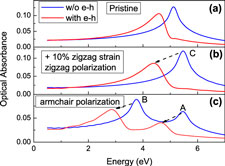Crossref Citations
This article has been cited by the following publications. This list is generated based on data provided by
Crossref.
Song, Wentao
Xie, Jian
Liu, Shuangyu
Cao, Gaoshao
Zhu, Tiejun
and
Zhao, Xinbing
2012.
Graphene-induced confined crystal growth of octahedral Zn2SnO4 and its improved Li-storage properties.
Journal of Materials Research,
Vol. 27,
Issue. 24,
p.
3096.
Spataru, Catalin D.
and
Léonard, François
2013.
Many-body effects on the electronic and optical properties of strained semiconducting carbon nanotubes.
Physical Review B,
Vol. 88,
Issue. 4,
Cao, Yiqi
Zhang, Lei
Tao, Duolei
Huo, Dexuan
and
Su, Kunpeng
2014.
Facile synthesis of CoSnO3/Graphene nanohybrid with superior lithium storage capability.
Electrochimica Acta,
Vol. 132,
Issue. ,
p.
483.
Kumar, Anshuman
Fung, Kin Hung
Homer Reid, M. T.
and
Fang, Nicholas X.
2014.
Transformation optics scheme for two-dimensional materials.
Optics Letters,
Vol. 39,
Issue. 7,
p.
2113.
Bulusheva, L. G.
Sedelnikova, O. V.
and
Okotrub, A. V.
2016.
Many‐body effects in optical response of graphene‐based structures.
International Journal of Quantum Chemistry,
Vol. 116,
Issue. 4,
p.
270.
Golze, Dorothea
Dvorak, Marc
and
Rinke, Patrick
2019.
The GW Compendium: A Practical Guide to Theoretical Photoemission Spectroscopy.
Frontiers in Chemistry,
Vol. 7,
Issue. ,
Saha, Saroj
and
Mandal, Swapan K.
2020.
Spin transition properties of metal (Zn, Mn) diluted Fe(phen)2(NCS)2 spin-crossover thin films.
The European Physical Journal Applied Physics,
Vol. 91,
Issue. 2,
p.
20301.
Saha, Saroj
Chandra, Paramesh
and
Mandal, Swapan K.
2022.
Spin state bistability in (Mn, Zn) doped Fe(phen)2(NCS)2 molecular thin film nanocrystals on quartz.
Physica B: Condensed Matter,
Vol. 642,
Issue. ,
p.
414128.
Dien, Vo Khuong
Han, Nguyen Thi
Bang‐Li, Wei
Lin, Kuang‐I
and
Lin, Ming‐Fa
2023.
Tuning of the Electronic and Optical Properties of Monolayer GaSe Via Strain.
Advanced Theory and Simulations,
Vol. 6,
Issue. 7,
Marinho, Enesio
Villegas, Cesar E. P.
Venezuela, Pedro
and
Rocha, Alexandre R.
2024.
Many-Body Effects on Electronic Properties and Optical Response of Single-Layer Penta-NiN2 for Infrared Optoelectronics.
ACS Applied Nano Materials,
Vol. 7,
Issue. 17,
p.
20176.
Hathcock, Megan
Hou, Ruiyang
Kovacevich, Dylan
Popa, Bogdan-Ioan
and
Wang, K.W.
2024.
Modulation of Dirac cones in phononic crystals with continuously varying lattice symmetry.
Physical Review Applied,
Vol. 22,
Issue. 6,
Wang, Zihan
and
Labat, Frédéric
2024.
Few layer graphene/TiO2 anatase (101) composites for photocatalytic applications: Electronic and optical properties from DFT and electrostatic embedding.
Applied Surface Science,
Vol. 669,
Issue. ,
p.
160383.
